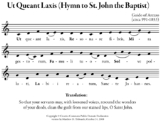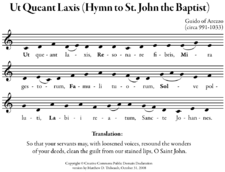
Ut queant laxis
Encyclopedia
Ut queant laxis or Hymnus in Ioannem are verses in honour of John the Baptist
written in Horatian Sapphics by Paulus Diaconus, the eighth century Lombard
historian. The musical origins are less clear, but the melody shares a common ancestor with the eleventh-century arrangement of Horace's Ode to Phyllis (4.11) recorded in the Montpellier manuscript H425.
It is notable in that each of the first six musical phrases of each stanza
of the hymn begins on a successively higher note
of the hexachord
. The first syllable of each hemistich (half line of verse) has given its name to a successive note, since these syllables coincide with the ascending note pattern. The last line, Sancte Iohannes, is an adonius after the three Sapphic hendecasyllables, and breaks the ascending pattern.
 In the Roman rite
In the Roman rite
, the hymn is sung in the Divine Office
on June 24, the Feast of the Nativity of John the Baptist
. The full hymn is divided into three parts, with Ut queant laxis sung at Vespers
, Antra deserti sung at Matins
, O nimis felix sung at Lauds
, and doxologies
added after the first two parts.
The first stanza is:
It may be translated: So that your servants may, with loosened voices, resound the wonders of your deeds, clean the guilt from our stained lips, O Saint John.
Ut is now mostly replaced by Do in solfège
due to the latter's open sound, in deference to Italian theorist Giovanni Battista Doni
.. The word "Ut" is still in use to name the C-clé
. The seventh note was not part of the medieval hexachord and does not occur in this melody, and it was originally called "si" from "Sancte Ioannes". In the nineteenth century, Sarah Glover, an English music teacher, renamed "si" by "ti" so that every syllable might begin with a different letter
. But this proposition had had no impact on the usage of "si" in the countries where "si" was already in use (in Romance languages, there is no confusion between the sound "si" and the sound "sol").
The use of Ut queant laxis to name the tones is usually attributed to Guido of Arezzo
in the eleventh century.
Melody:
John the Baptist
John the Baptist was an itinerant preacher and a major religious figure mentioned in the Canonical gospels. He is described in the Gospel of Luke as a relative of Jesus, who led a movement of baptism at the Jordan River...
written in Horatian Sapphics by Paulus Diaconus, the eighth century Lombard
Lombards
The Lombards , also referred to as Longobards, were a Germanic tribe of Scandinavian origin, who from 568 to 774 ruled a Kingdom in Italy...
historian. The musical origins are less clear, but the melody shares a common ancestor with the eleventh-century arrangement of Horace's Ode to Phyllis (4.11) recorded in the Montpellier manuscript H425.
It is notable in that each of the first six musical phrases of each stanza
Stanza
In poetry, a stanza is a unit within a larger poem. In modern poetry, the term is often equivalent with strophe; in popular vocal music, a stanza is typically referred to as a "verse"...
of the hymn begins on a successively higher note
Note
In music, the term note has two primary meanings:#A sign used in musical notation to represent the relative duration and pitch of a sound;#A pitched sound itself....
of the hexachord
Hexachord
In music, a hexachord is a collection of six pitch classes including six-note segments of a scale or tone row. The term was adopted in the Middle Ages and adapted in the twentieth-century in Milton Babbitt's serial theory.-Middle Ages:...
. The first syllable of each hemistich (half line of verse) has given its name to a successive note, since these syllables coincide with the ascending note pattern. The last line, Sancte Iohannes, is an adonius after the three Sapphic hendecasyllables, and breaks the ascending pattern.

Roman Rite
The Roman Rite is the liturgical rite used in the Diocese of Rome in the Catholic Church. It is by far the most widespread of the Latin liturgical rites used within the Western or Latin autonomous particular Church, the particular Church that itself is also called the Latin Rite, and that is one of...
, the hymn is sung in the Divine Office
Liturgy of the hours
The Liturgy of the Hours or Divine Office is the official set of daily prayers prescribed by the Catholic Church to be recited at the canonical hours by the clergy, religious orders, and laity. The Liturgy of the Hours consists primarily of psalms supplemented by hymns and readings...
on June 24, the Feast of the Nativity of John the Baptist
John the Baptist
John the Baptist was an itinerant preacher and a major religious figure mentioned in the Canonical gospels. He is described in the Gospel of Luke as a relative of Jesus, who led a movement of baptism at the Jordan River...
. The full hymn is divided into three parts, with Ut queant laxis sung at Vespers
Vespers
Vespers is the evening prayer service in the Western Catholic, Eastern Catholic, and Eastern Orthodox, Anglican, and Lutheran liturgies of the canonical hours...
, Antra deserti sung at Matins
Matins
Matins is the early morning or night prayer service in the Roman Catholic, Anglican, Lutheran and Eastern Orthodox liturgies of the canonical hours. The term is also used in some Protestant denominations to describe morning services.The name "Matins" originally referred to the morning office also...
, O nimis felix sung at Lauds
Lauds
Lauds is a divine office that takes place in the early morning hours and is one of the two major hours in the Roman Catholic Liturgy of the Hours. In the Eastern Orthodox tradition, it forms part of the Office of Matins...
, and doxologies
Doxology
A doxology is a short hymn of praises to God in various Christian worship services, often added to the end of canticles, psalms, and hymns...
added after the first two parts.
The first stanza is:
- Ut queant laxis
- resonare fibris,
- Mira gestorum
- famuli tuorum,
- Solve polluti
- labii reatum,
- Sancte Iohannes.
It may be translated: So that your servants may, with loosened voices, resound the wonders of your deeds, clean the guilt from our stained lips, O Saint John.
Ut is now mostly replaced by Do in solfège
Solfege
In music, solfège is a pedagogical solmization technique for the teaching of sight-singing in which each note of the score is sung to a special syllable, called a solfège syllable...
due to the latter's open sound, in deference to Italian theorist Giovanni Battista Doni
Giovanni Battista Doni
Giovanni Battista Doni was an Italian musicologist who made an extensive study of ancient music. Known, among other works, for having changed the name of note Ut renaming it Do after his own family name to ease solfege.- Life :...
.. The word "Ut" is still in use to name the C-clé
CLE
CLE may refer to:* Current-limiting element, a fuse designed to limit current in power systems* Central Landing Establishment* Chemical Langevin equation, a stochastic ordinary differential equation...
. The seventh note was not part of the medieval hexachord and does not occur in this melody, and it was originally called "si" from "Sancte Ioannes". In the nineteenth century, Sarah Glover, an English music teacher, renamed "si" by "ti" so that every syllable might begin with a different letter
Tonic sol-fa
Tonic sol-fa is a pedagogical technique for teaching sight-singing, invented by Sarah Ann Glover of Norwich, England and popularised by John Curwen who adapted it from a number of earlier musical systems...
. But this proposition had had no impact on the usage of "si" in the countries where "si" was already in use (in Romance languages, there is no confusion between the sound "si" and the sound "sol").
The use of Ut queant laxis to name the tones is usually attributed to Guido of Arezzo
Guido of Arezzo
Guido of Arezzo or Guido Aretinus or Guido da Arezzo or Guido Monaco or Guido d'Arezzo was a music theorist of the Medieval era...
in the eleventh century.
Melody:
See also
- Diatonic and chromaticDiatonic and chromaticDiatonic and chromatic are terms in music theory that are most often used to characterize scales, and are also applied to intervals, chords, notes, musical styles, and kinds of harmony...
- GamutGamutIn color reproduction, including computer graphics and photography, the gamut, or color gamut , is a certain complete subset of colors. The most common usage refers to the subset of colors which can be accurately represented in a given circumstance, such as within a given color space or by a...
- Guidonian handGuidonian handIn Medieval music, the Guidonian hand was a mnemonic device used to assist singers in learning to sight-sing. Some form of the device may have been used by Guido of Arezzo, a medieval music theorist who wrote a number of treatises, including one instructing singers in sightreading...
- SolmizationSolmizationSolmization is a system of attributing a distinct syllable to each note in a musical scale. Various forms of solmization are in use and have been used throughout the world.In Europe and North America, solfège is the convention used most often...
- SolfègeSolfegeIn music, solfège is a pedagogical solmization technique for the teaching of sight-singing in which each note of the score is sung to a special syllable, called a solfège syllable...
- Stuart Lyons, "Music in the Odes of Horace" (2010), Oxford, Aris & Phillips, ISBN 978-0-85668-844-7.

